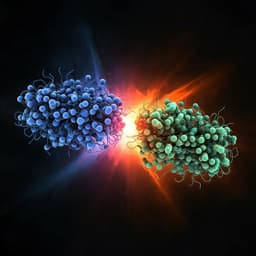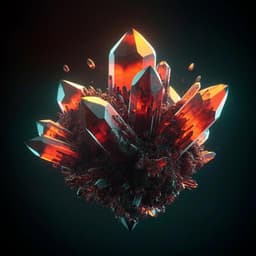
Chemistry
Prediction of transition state structures of gas-phase chemical reactions via machine learning
S. Choi
This groundbreaking study by Sunghwan Choi unveils a machine learning model that predicts transition state structures in organic reactions with remarkable accuracy. Achieving a 93.8% success rate, this innovative approach enhances our understanding of chemical reaction mechanisms.
~3 min • Beginner • English
Introduction
Transition states (TSs) govern reaction mechanisms via the potential energy surface (PES), and many reaction properties can be derived from TS structures using classical TS theory. Although quantum chemical methods accurately locate saddle points on PESs, they require well-constructed initial structures and are computationally demanding; even experts often resort to numerous trial-and-error attempts to design appropriate starting geometries. ML has successfully predicted various molecular and reaction properties, but inferring physically valid 3D structures is challenging due to permutation, rotational, translational, and Euclidean constraints. Recent ML approaches (e.g., TSGen and TSNet) can predict TS structures while honoring these constraints, but often specialize in specific reaction types, limiting applicability across the broader chemical reaction space. This work proposes a general ML model that predicts TS interatomic distances from reactant, product, and linearly interpolated structures to provide high-quality TS initial guesses and enable exploration of multiple reaction pathways.
Literature Review
Prior work has applied ML broadly in chemistry to predict energies and activation barriers with high accuracy. For TS structure prediction, Pattanaik et al. (TSGen) used a graph neural network to generate an initial interatomic distance matrix from reactant and product distances and then performed internal optimization to obtain coordinates. Jackson et al. (TSNet) used a tensor-field network with spherical harmonics to directly predict TS atomic positions. While these satisfy necessary invariances for 3D structure prediction, they tend to be specialized or less accurate in challenging regimes (e.g., bond formation/breakage). The need remains for a generalizable approach that robustly handles diverse reactions without relying on mechanism-specific priors.
Methodology
The proposed model predicts TS interatomic distances using three input structures per reaction: reactant, product, and a linearly interpolated geometry. Each structure is encoded as a set of atomic pair features formed by concatenating embedded atomic numbers with a Gaussian-expanded interatomic distance. A novel Pair Sequence Interaction (PSI) layer processes these features in two stages: (1) a transformer encoder updates pair features within each structure (permutation-invariant and size-extensive), and (2) a bidirectional GRU exchanges information across corresponding atomic pairs of the three structures, preserving permutation invariance/size extensivity via known atom mappings. Stacking two PSI layers yields enriched pair features used by two readouts: (i) a distance readout predicts the ratio d_TS/d_interp for each pair, and (ii) a property readout (multi-label option) estimates per-atom contributions to energy and entropies for reactant/product/TS (found not to improve distance accuracy in final models). Predicted TS distance matrices are converted to 3D coordinates via a subsequent nonlinear optimization that minimizes the squared deviations between reconstructed and predicted distances. Short distances are emphasized with Gaussian weights (α = 0.2 Å⁻²). To improve robustness, an ensemble of models (90 total, trained with different seeds/hyperparameters/epochs) provides multiple distance predictions combined into a single nonlinear optimization. Test-time augmentation (TTA) averages predictions from forward and reverse reaction representations to enforce direction-independence. Training data: Grambow et al.’s ωB97X-D3/def2-TZVP reaction set (11,961 reactions) split 80/10/10 into train/validation/test; also an SN2 set (53 reactions; 48 train, 5 validation). Metrics include molecular MAE and MAPE of interatomic distances. For quantum chemical validation of predicted TS geometries, saddle point optimizations were performed (Q-Chem, same ωB97X-D3/def2-TZVP level as reference) and followed by frequency/IRC checks (Pysisyphus + Psi4). For multi-path exploration, normal mode sampling (NMS) generated 2,000 off-equilibrium reactant/product structures; predicted TSs were clustered (117 representatives) and selected structures were refined via saddle point optimization to identify distinct TS conformations.
Key Findings
- Overall prediction accuracy on the Grambow test set: Single-model MAPE/MAE 3.681%/11.56 pm; Ensemble 3.407%/10.70 pm. With TTA: Single 3.642%/11.44 pm; Ensemble 3.404%/10.69 pm. With TTA + nonlinear optimization: Single 3.365%/10.29 pm; Ensemble 3.083%/9.53 pm.
- Compared to baselines: TSGen/TSNet MAPE 7.738%/9.229% and MAE 22.46/24.37 pm on the same data; the proposed model halves or better these errors.
- Critical bond-change pairs: Despite their rarity (formation 1.27%, breakage 1.96% of pairs), ensemble errors are ≤ ~5% in these categories, while TSGen/TSNet exceed ~15%.
- Distance-dependent accuracy: Across interatomic distance ranges, including bonding regions (<156.6 pm), the ensemble keeps errors ≤ ~6%, outperforming baselines that reach ≥15%.
- Small-data performance (SN2 set): Ensemble MAPE 1.738%, MAE 4.54 pm; using TSNet’s error definition, 4.97 pm (vs. TSNet’s best 18.31 pm), showing >3× improvement with only 48 training examples.
- Data efficiency: Training on only 25% of Grambow’s training set still outperforms baselines trained on the full set.
- Quantum chemical validation (Grambow test set, 1196 reactions): Saddle point optimizations converged for 1122 cases (93.8%). Of all test cases, 956 (80.0%) had a single negative frequency. Among converged optimizations, 996 (88.8%) had absolute energy errors <0.1 kcal mol−1 relative to reference TS energies.
- Energy error vs. chemical validity: Low energy error does not guarantee correct IRC connectivity; some TSs with small errors failed IRC, while some with >10 kcal mol−1 error succeeded, reflecting non-uniqueness of reaction paths and database issues.
- Multi-path exploration: For a difficult case, 2,000 NMS samples and ensemble inference produced 117 clustered TS candidates; 24 converged distinct TSs revealed four conformations. Three conformations yielded correct IRC endpoints; one matched the reference conformation but did not lead to the target products, highlighting potential reference database inconsistencies.
Discussion
The model addresses the challenge of generating reliable TS initial structures by predicting interatomic distances from reactant, product, and interpolated geometries, then reconstructing 3D coordinates under Euclidean constraints. It achieves markedly improved accuracy over prior TSNet/TSGen baselines, especially for bond-forming/breaking pairs that are crucial for chemical correctness yet underrepresented in data. High saddle point convergence (93.8%) and a large fraction of optimized TSs with negligible energy error (<0.1 kcal mol−1) demonstrate the practical utility of the predicted structures as starting points for quantum refinement. The analysis shows that interatomic distance accuracy alone does not ensure energetic or mechanistic validity, underscoring the necessity of quantum refinement and IRC checks. The multi-path exploration workflow combining NMS with ensemble predictions efficiently identifies multiple plausible TS conformers, enabling discovery of alternative reaction pathways. Observed discrepancies between predicted/optimized TS energies and reference structures suggest possible data issues and the inherent non-uniqueness of TSs along different reaction paths, but the approach remains robust and broadly applicable to general organic reactions.
Conclusion
This work introduces a general ML architecture leveraging Pair Sequence Interaction layers to predict TS interatomic distances from reactant, product, and interpolated structures, followed by nonlinear optimization to reconstruct 3D geometries. The approach delivers state-of-the-art accuracy on a large, diverse reaction set, excels for bond-change pairs, and yields high success as initial guesses for saddle point optimization. It also enables efficient exploration of multiple reaction pathways from off-equilibrium inputs. Future directions include: integrating advanced configuration sampling for initial reactant/product poses (especially for multi-molecular reactions), combining TTA, ensembling, and high-level quantum methods for more rigorous TS prediction, addressing chirality determination explicitly, and leveraging the framework for autonomous reaction discovery and active learning.
Limitations
- Chirality ambiguity: Distance-based predictions cannot distinguish enantiomers; reconstructed TSs may have incorrect chirality not captured by distance-based metrics.
- Dependence on initial structures and atom mapping: Requires aligned reactant/product structures and accurate atom mappings; initial relative poses (notably in bi-/trimolecular reactions) critically influence outcomes.
- Optimization sensitivities: Saddle point convergence depends on quantum optimization settings; some failures arise from SCF or iteration limits rather than ML predictions.
- Energy error vs. mechanistic validity: Low energy error does not guarantee correct IRC endpoints; additional validation is necessary.
- Data quality: Potential inconsistencies in the reference TS database affect evaluation; widespread IRC validation is computationally expensive.
- Multi-task losses (energy/entropy) did not improve distance predictions in this work, suggesting limited benefit of auxiliary labels under current setup.
Related Publications
Explore these studies to deepen your understanding of the subject.







